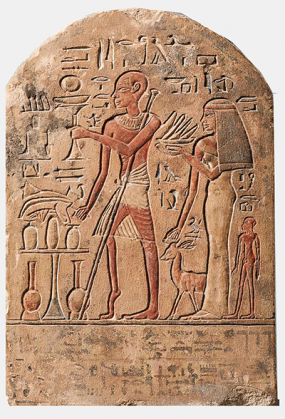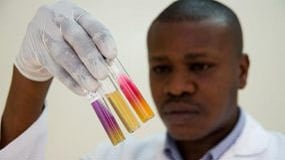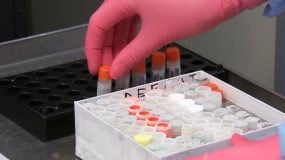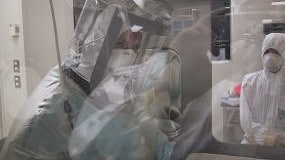
What is Polio?
- Polio, or poliomyelitis, is a disabling and life-threatening disease caused by the poliovirus.
- The virus spreads from person to person and can infect a person’s spinal cord, causing paralysis (can’t move parts of the body).
Symptoms
Most people who get infected with poliovirus will not have any visible symptoms.
About 1 out of 4 people (or 25 out of 100) with poliovirus infection will have flu-like symptoms that can include:
- Sore throat
- Fever
- Tiredness
- Nausea
- Headache
- Stomach pain
These symptoms usually last 2 to 5 days, then go away on their own.
A smaller proportion of people with poliovirus infection will develop other, more serious symptoms that affect the brain and spinal cord:
- Meningitis (infection of the covering of the spinal cord and/or brain)occurs in about 1–5 out of 100 people with poliovirus infection, depending on virus type
- Paralysis (can’t move parts of the body) or weakness in the arms, legs, or both occurs in about 1 out of 200 people to 1 in 2000 people, depending on the virus type
Paralysis is the most severe symptom associated with poliovirus because it can lead to permanent disability and death. Between 2 and 10 out of 100 people who have paralysis from poliovirus infection die, because the virus affects the muscles that help them breathe.
Even children who seem to fully recover can develop new muscle pain, weakness, or paralysis as adults, 15 to 40 years later. This is called post-polio syndrome.
Note that “poliomyelitis” (or “polio” for short) is defined as a paralytic disease. So only people with the paralytic infection are considered to have the disease.
Post-Polio Syndrome (PPS)

Polio has been around since ancient times. This ancient Egyptian tomb painting shows a man with a withered leg unable to bear weight without the use of a walking stick. This means that most muscle fibers are replaced with scarring (muscle-wasting) that is permanent.
If someone had polio as a child or young adult but had kept or recovered some or all movement of weakened arms or legs, even to the point of being athletic afterward, they can become weaker in late adulthood. That is a post-polio syndrome (PPS), a condition that can affect polio survivors decades after they recover from their initial poliovirus infection. Some PPS patients become wheelchair-bound when they had not been before.
Transmission
- Poliovirus is very contagious and spreads through person-to-person contact.
- It lives in an infected person’s throat and intestines.
- It can contaminate food and water in unsanitary conditions.
Poliovirus only infects people. It enters the body through the mouth. It spreads through:
- Contact with the feces (poop) of an infected person
- Droplets from a sneeze or cough of an infected person (less common)
You can get infected with poliovirus if:
- You have picked up minute pieces of feces on your hands, and you touch your mouth.
- You put in your mouth objects like toys that are contaminated with feces.
An infected person can spread the virus to others immediately before and up to 2 weeks after symptoms appear.
- The virus can live in an infected person’s intestines for many weeks. It can contaminate food and water in unsanitary conditions.
- People who don’t have symptoms can still pass the virus to others and make them sick.
Prevention
There are two types of vaccines that can prevent polio:
- Inactivated poliovirus vaccine (IPV) is given as an injection in the leg or arm, depending on the patient’s age. Only IPV has been used in the United States since 2000.
- The oral poliovirus vaccine (OPV) is still used throughout much of the world.
The Polio vaccine protects children by preparing their bodies to fight the poliovirus. Almost all children (more than 99 percent) who get all the recommended doses of the inactivated polio vaccine will be protected from polio.
It is also very important to practice good hand hygiene and wash hands often with soap and water. Note that alcohol-based hand sanitizers do not kill poliovirus.
Diagnosis
Healthcare providers who suspect a patient has polio should hospitalize the patient right away, do a physical exam, take a detailed medical history, including vaccination history and history of any recent travel, collect samples (stool, throat swab, blood, urine, and spinal fluid), and obtain a magnetic resonance imaging (MRI) to look at pictures of the spinal cord. Poliovirus is most likely to be detected in stool specimens.
Treatment
There is no cure for paralytic polio and no specific treatment.
Physical or occupational therapy can help with arm or leg weakness caused by polio and might improve long-term outcomes, especially if implemented early in the course of illness. Healthcare providers should consider consulting neurology and infectious disease experts to discuss possible treatments and recommend certain interventions on a case-by-case basis.
If you think you or someone in your family has symptoms of polio, please call your healthcare provider right away or go to an emergency room.
Diagnosis, Specimens, & Containment
Diagnosis

CDC laboratories conduct testing for poliovirus including culture, PCR, genome sequencing, and serology.
Specimens

CDC guidance on maintaining the integrity of specimens for collection, storage, and shipment.
Containment

CDC containment of the poliovirus is critical to minimizing the risk of the virus causing harm to the environment.
CDC Related Links
- What everyone should know (NCIRD)
- Who needs to get vaccinated (NCIRD)
- Polio: For Travelers
- Find a travel medicine clinic (NCEZID)
- For Healthcare Providers
Page last reviewed: August 11, 2022
Content source: Global Immunizatio
